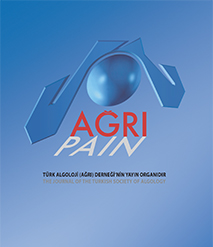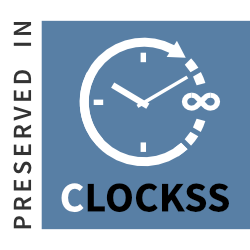Quick Search
Volume: 30 Issue: 1 - 2018
| EXPERIMENTAL AND CLINICAL STUDIES | |
| 1. | Effect of intravenous preoperative versus postoperative paracetamol on postoperative nausea and vomiting in patients undergoing strabismus surgery: A prospective randomized study Mehmet Aksoy, İlker İnce, Ali Ahıskalıoğlu, Sadullah Keleş, Ömer Doymuş PMID: 29450877 doi: 10.5505/agri.2017.65872 Pages 1 - 7 Objectives: This prospective randomized study aimed to compare the efficacy of preoperative versus postoperative paracetamol on postoperative nausea and vomiting (PONV) in children undergoing strabismus surgery. Methods: Ninety-six patients were randomly divided into three equal groups (n=32). In the preoperative paracetamol group, patients received intravenous (IV) infusion of paracetamol [15 mg kg−1 (1.5 ml kg−1)] 1 h before surgery over 20 min and that of saline (1.5 ml kg−1) in the recovery room. In the postoperative paracetamol group, patients received IV infusion of saline (1.5 ml kg−1) 1 h before surgery over 20 min and that of paracetamol [15 mg kg−1 (1.5 ml kg−1)] in therecovery room. In the control group, patients received the IV infusion of saline (1.5 ml kg−1) pre- and postoperatively. Postoperative pain condition was evaluated using the Faces Pain Scale. In the recovery room, an observer recorded the pain score, complaints of nausea and vomiting, the need for rescue analgesics, and the need for antiemetic drug during 24 h postoperatively. Results: The incidence of nausea and vomiting during the first 0–6 h postoperatively was significantly lower in the preoperative paracetamol group than in the control and postoperative paracetamol groups (p<0.001). The number of patients requiring antiemetic administration during the first 0–6 and 6–12 h postoperatively was found to be higher in the control group than in the other groups (p<0.001, for all). Conclusion: The preoperative administration of paracetamol reduces PONV incidence in children undergoing strabismus surgery. |
| 2. | Early and long period follow-up results of low glycemic index diet for migraine prophylaxis Gökhan Evcili, Uygar Utku, Muhammed Nur Öğün, Gökhan Özdemir PMID: 29450870 doi: 10.5505/agri.2017.62443 Pages 8 - 11 Objectives: The role of dietary restriction in the management of patients with migraine is still a controversial topic in the headache field. The aim of this study was to evaluate the efficacy of dietary restriction on migraine attacks. Methods: Patients diagnosed with migraine without aura according to the International Classification of Headaches were enrolled. Our study included 350 migraine patients evaluated at the neurology headache outpatient clinic. They were randomly divided into two groups: diet group as the study group and medication group as the control group. We told migraine patients to make lifestyle changes, especially those with low glycemic index in the diet group. On the other hand, propranolol, amitriptyline, flunarizine, and topiramate were used for the prophylaxis in the medication group. The frequency and severity of attacks [using the visual analog scale (VAS)] were recorded before starting dietary restriction and 1 and 3 months after the dietary restriction. Results: There were 350 participants in this study. After 3 months, a total of 147 patients (male/female: 17/130, mean age: 34.7±5.9) were evaluated in the diet group. The control group consisted of 147 age- and sex-matched, randomly selected patients with migraine without aura. In the first month after dietary restriction, monthly attack frequency significantly decreased in both groups but not the VAS score. The mean scores of VAS significantly decreased later in the diet group compared with those in the medication group (after 3 months). Conclusion: The results of the study revealed that low glycemic index diet intake can be an effective and reliable method to reduce migraine attacks. |
| 3. | Characteristics of headache and its relationship with disease severity in patients with Crimean–Congo hemorrhagic fever Dürdane Aksoy, Hatice Barut, Fazilet Duygu, Betül Çevik, Semiha Kurt, Orhan Sümbül PMID: 29450871 doi: 10.5505/agri.2017.76259 Pages 12 - 17 Objectives: Crimean–Congo Hemorrhagic Fever (CCHF) is a fatal, tick-borne disease. The classic clinical presentation of CCHF is characterized by sudden onset of high fever, chills, and severe headache. There are no previous reports on the characteristics of headaches caused by CCHF. Therefore, we investigated the relationship between CCHF-induced headache and the clinical course of the disease. Methods: We included 60 patients with headache diagnosed with CCHF; they were divided into two groups: group 1 included patients with hospital stay <7 days and group 2 included patients with hospital stay >7 days. The control group included 43 viral pneumonia patients with headache. Patients described the characteristics of headaches and also self-rated the severity with a numeric pain scale that classified headache as either mild or severe. Results: In the group with CCHF, 66.7% of the reported headaches met criteria for diagnosis of migraine. This ratio was significantly higher than that in the control group (37.5%). The headache severity scores in group 1 were lower than those in group 2. The hospitalization length was shorter (p=0.004) and the platelet levels were higher in CCHF patients with mild headache compared with CCHF patients with severe headache (p=0.005). Conclusion: CCHF patients had more often and severe headaches than the controls. The severity of headache may be associated with the severity of vascular endothelial damage, vasodilatation, and abnormal release of inflammatory cytokines in CCHF similar in migraine. Most CCHF patients experienced migraine-like headaches, suggesting that cerebral vessel involvement might be important in both CCHF and migraine. |
| 4. | Turkish validity and reliability study of fear of pain questionnaire-III Seher Ünver, Fatma Nesrin Turan PMID: 29450872 doi: 10.5505/agri.2017.62681 Pages 18 - 27 Objectives: This study aimed to develop a Turkish version of the Fear of Pain Questionnaire-III developed by McNeil and Rainwater (1998) and examine its validity and reliability indicators. Methods: The study was conducted with 459 university students studying in the nursing department. The Turkish translation of the scale was conducted by language experts and the original scale owner. Expert opinions were taken for language validity, and the Lawshe’s content validity ratio formula was used to calculate the content validity. Exploratory factor analysis was used to assess the construct validity. The factors were rotated using the Varimax rotation (orthogonal) method. For reliability indicators of the questionnaire, the internal consistency coefficient and test re-test reliability were utilized. Results: Explanatory factor analyses using the three-factor model (explaining 50.5% of the total variance) revealed that the item factor loads varied were above the limit value of 0.30 which indicated that the questionnaire had good construct validity. The Cronbach’s alpha value for the total questionnaire was 0.938, and test re-test value was 0.846 for the total scale. Conclusion: The Turkish version of the Fear of Pain Questionnaire-III had sufficiently high reliability and validity to be used as a tool in evaluating the fear of pain among the young Turkish population. |
| CASE REPORTS | |
| 5. | Peripheral nerve blocks for the treatment of short-lasting unilateral neuralgiform headache with conjunctival injection and tearing (SUNCT) during pregnancy Osman Özgür Yalın, Derya Uludüz, Aynur Özge PMID: 29450873 doi: 10.5505/agri.2016.25991 Pages 28 - 30 Short-lasting unilateral neuralgiform headache attacks with conjunctival injection and tearing (SUNCT) is a rare, primary headache syndrome, which is classified as a subtype of trigeminal autonomic cephalalgias. Although SUNCT is usually refractory to treatment, several antiepileptic drugs have recently shown promising results for its treatment. However, there is a lack of evidence regarding the course of SUNCT during pregnancy and the available treatment options. Here, we present a 30-week pregnant female with SUNCT who was successfully treated with infra- and supraorbital nerve blocks. Headache attacks completely diminished after the injection, and recurrence was not observed. Although lamotrigine may be relatively safe in pregnant patients with SUNCT attacks, peripheral nerve block may be a feasible technique and can be considered as a safe and effective treatment option. This is the first SUNCT case in the literature that was successfully treated with infra- and supraorbital nerve blocks during pregnancy. |
| 6. | What happened? An inexplicable case: Accidental subdural block Ömer Karaca, Ali Ahıskalıoğlu, Mehmet Aksoy, Rafi Dogan, Elif Oral Ahıskalıoğlu PMID: 29450874 doi: 10.5505/agri.2016.68736 Pages 31 - 34 Epidural block is an appropriate anesthesia method for outpatient operation. This technique is generally safe and efficient. We present the case of a 20-year-old female patient with accidental subdural block after a single dose of epidural block for pilonidal sinus surgery. Sudden apnea, unconsciousness, and bilateral mydriasis occurred within a few minutes after injection. Within 80 minutes after injection, the patient regained full consciousness and spontaneous respiration, with motor block in lower extremities and sensory block until the T4 level. Motor block continued until 165 minutes after injection, whereas sensory block ended 225 minutes later. |
| 7. | Coexistence of polymyalgia rheumatica with ankylosing spondylitis: A case report Ali Aydeniz, Mazlum Serdar Akaltun, Ali Gür, Savaş Gürsoy PMID: 29450875 doi: 10.5505/agri.2016.69672 Pages 35 - 37 Ankylosing spondylitis is a chronic inflammatory disease that affects the spine and peripheral joints. Polymyalgia rheumatica is an inflammatory disease characterized by aching and prolonged morning stiffness mainly in the shoulder and pelvic girdles. Many other diseases may mimic polymyalgia rheumatica, and thus differential diagnosis is predominantly required. A wide variety of diseases, including spondyloarthropathies, may present polymyalgia-like symptoms, and two diseases rarely coexist. We present a case of a 54-year-old man who had been followed-up for ankylosing spondylitis and presented with pain in the shoulder and pelvic girdles, restricted movement, and morning stiffness for 2 months. Physical examination revealed that the pain was located mostly in the shoulder and pelvic girdles. In addition, increased erythrocyte sedimentation rate revealed the coexistence of the two diseases. Corticosteroid treatment dramatically improved the patient’s symptoms and supported the diagnosis. This case demonstrated that ankylosing spondylitis may present polymyalgia-like symptoms, and the two diseases may rarely coexist in the elderly. The coexistence of these two diseases has been rarely reported in literature. Accurate diagnosis of the two diseases is essential for improving the patient’s symptoms and quality of life. |
| LETTER TO THE EDITOR | |
| 8. | Intravenous fentanyl as the treatment for intraoperative hiccups: A case report Anbarasan Ardhanari PMID: 29450876 doi: 10.5505/agri.2017.33603 Page 38 Abstract | |





